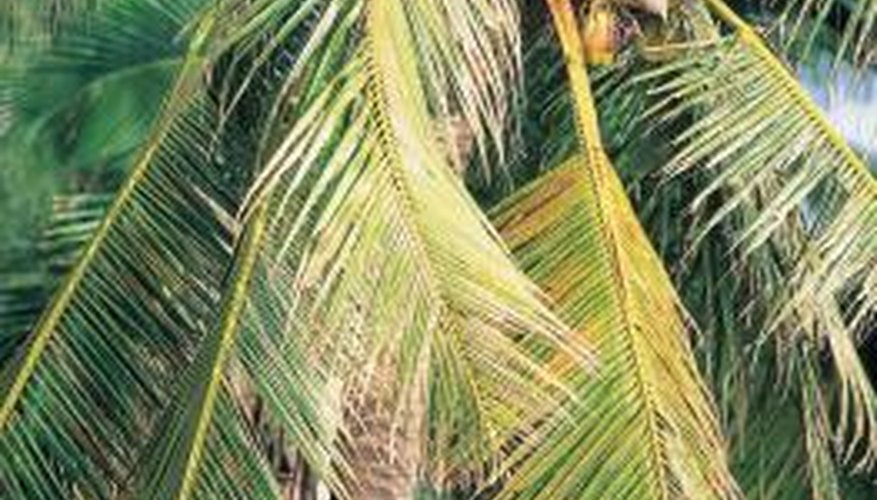With the fruit's wide array of uses in foods, lotions and other products, coconuts (Cocos nucifera) are sometimes referred to as "the tree of life." Amazingly adaptable, this palm's ability to spread its seeds and grow in a variety of conditions allowed it to become a pan-tropical species. Originally, coconuts grew in the southwestern Pacific, but today they grow extensively around the tropics. Coconut palm's only limitations are freezing temperatures, flooded soil and drought.
Growth Characteristics
Coconut palms grow moderately fast, adding 12 to 20 inches of trunk length annually. After germinating from seed, it develops a basal trunk within four years of growth. This allows coconut seeds to sprout in both warm, shady and warm, sunny spots and send up leaves over competing shrubs and herbaceous weeds. The plants survive in shady locales, but then grow quickly once surrounding trees fall down to expose sunlight. The trunk is sturdy but flexible, supported by many long roots that will keep a coconut palm alive after tipping over or leaning.
- Coconut palms grow moderately fast, adding 12 to 20 inches of trunk length annually.
- The trunk is sturdy but flexible, supported by many long roots that will keep a coconut palm alive after tipping over or leaning.
Seed Features
The coconuts that form at the base of the canopy atop a coconut palm are large, fibrous and buoyant. As they mature and drop, wind and water can transport the coconut great distances. Seawater does not kill the round seed inside the air-filled, fibrous husk. Coconut seeds are able to immediately germinate, they require no dormancy or treatment to cold or cracking to sprout. Wherever the coconut rests, the milky water inside the seed provides ample moisture to sustain the seedling as it sprouts, even in seasonally dry beach sands. The durability of the coconut allows the species to travel great distances to populate new lands and sprout in seemingly less than ideal conditions.
- The coconuts that form at the base of the canopy atop a coconut palm are large, fibrous and buoyant.
- Coconut seeds are able to immediately germinate, they require no dormancy or treatment to cold or cracking to sprout.
Climate Tolerances
While not able to survive temperatures below 00 degrees Celsius, the coconut palm has no problem tolerating oppressive humidity and summer heat. The flexible trunk coupled with the flexible, large fronds with slender leaflets make it extremely wind-resistant. It's one of the most wind-tolerant trees in the world, according to the Pacific Island Agroforestry. This prevents tropical storms from destroying leaves or decapitating the palm of its lone growing tip. Coconut palms grow well in tropical regions where rainfall is constant year-round or where there are alternating cycles of wet and dry seasons.
- While not able to survive temperatures below 00 degrees Celsius, the coconut palm has no problem tolerating oppressive humidity and summer heat.
Soil Conditions
Coconut palms prosper in any well-draining soil that is not dense or compacted. It grows well in sand, loam or crumbly clays. Although the ideal soil is slightly acidic, pH 5.5 to 7, coconut palms will grow in any soil from 4.5 to 8. Roots are mainly lateral and wide-spreading in the top 5 feet of soil. It grows in deep soils or in shallow layers of organic matter and sand atop coral or shell sub-layers 10 to 18 inches below the soil surface. Only waterlogged soils limit the growth and duration of coconut palms in a tropical landscape.
- Coconut palms prosper in any well-draining soil that is not dense or compacted.
